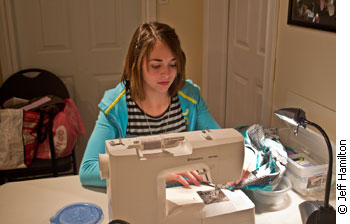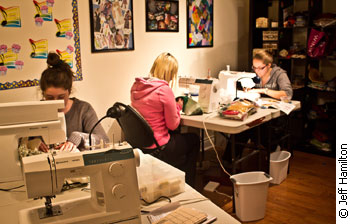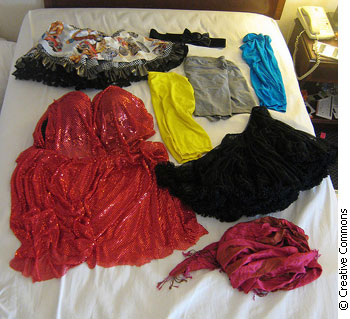Tags
Related Posts
Share This
Why sewing is back in fashion
 It was love at first sight for Isobel Vaisanen. When asked how she got involved in a sewing class, the 11 year old recalls the moment of her infatuation. Her local Greely, Ontario, sewing club holds an annual fashion show that features pieces by members; Isobel attended as a fifth grader.
It was love at first sight for Isobel Vaisanen. When asked how she got involved in a sewing class, the 11 year old recalls the moment of her infatuation. Her local Greely, Ontario, sewing club holds an annual fashion show that features pieces by members; Isobel attended as a fifth grader.“I was amazed at how they did the sewing,” she says, “and I really wanted to join.” Which she did that following summer.
Fast forward, and Isobel is now into her second year of the craft, mastering projects that include clothes and full-sized quilts. Her most prized possession: a dress she hand-made for her fifth grade graduation. “A lot of people thought it was the best dress they’ve ever seen,” she says.

Craft apprentice: Kianna Levine, 14, makes a quilt in sewing class.
Janet Pray is executive director of the National Sewing Council in the United States. The council is responsible for attending craft shows across the country and educating the public on the ins and outs of sewing. She says that Isobel’s story is just one example of a current trend: young sewers joining.
“We’ve definitely seen a rise in youths sewing,” she says. “We meet new, young sewers at almost every event, and the number is continuing to grow.”
While statistics on youth involvement remain elusive, a current general rise in sewing’s popularity is amply attested. For example, according to Time magazine, there are about 35 million sewing hobbyists in the United States, up from 30 million in 2000, while annual sales of Singer sewing machines have doubled since 1999, to 3 million.
Runway dreams
When asked why more young people are joining a craft usually associated with oldsters, Pray is quick to reply: “Project Runway! It’s created a brand-new way to look at sewing.” Project Runway is a reality TV series, now in its sixth season since 2006, that showcases wanna-be designers vying to have their patterns shown in New York. Pray says the show’s popularity “has shown teenage girls that sewing can be both a career decision and a creative outlet.”
‘Project Runway has created a brand-new way to look at sewing’ — expert Janet Pray
Sherry Pettigrew works at Dragonfly Fabrics in Ottawa, where she teaches a beginners’ sewing class. Over the years she has noticed a steady climb in numbers of teenaged students. Some, she says, have joined to better their chances of getting accepted into fashion schools such as Ryerson’s, in Toronto.
Tori Hill, 17, has been sewing for the six years. When asked why she began, she echoes the dream of many girls her age. “I’ve always wanted to be a fashion designer,” she says. “The skills I learn here allow me to make my own designs.” Like many young fashionistas, Tori hopes one day to see her clothes on the catwalk.
But it’s not just career ambition that draws young people to sewing, says Pray. Because so much youthful creativity these days is expressed through electronics, she argues, a hands-on productive activity like sewing can provide special gratification. “If a young girl makes a clutch bag, she’s made something she uses all the time. She gets total creative control. And to hear all the positive feedback from family and friends is a feeling like no other.”
Cost effective
Anne Warren has been teaching sewing for over 20 years, currently for the Kid’s Sewing Company, a program in Nanaimo, BC, designed specifically for ages eight to seventeen. Warren has more than 30 students and runs three-hour classes five days a week. She says her enrolment is up, which she attributes to a shaky economy. “When the economy is down, my numbers usually go up.” She says sewing is less expensive among the hobbies and is often a better fit for a families on tighter budgets.
Michele Santerre owns The Running Stitch, a quilt store in Kanata, Ontario. She says the boost in young sewers has to do with fabrics being available for purchase by Internet. “Younger people can now find fabrics cheaper online.” Because fabric prices have gone down in this way, she says, youths can join a hobby that was once too expensive. She says the influx of young sewers has resulted in her “buying more modern fabrics.” Further to attract younger customers, Santerre has begun advertising with Groupon, a website that offers a daily deal on the most “popular things to do, see, eat and buy” and that provides users with a “daily coupon,” good at a local merchant.

Hamilton’s students enjoy their sewing class’s relaxed setting.
A ‘sewcial’ scene
And not least of all, the social element has contributed to sewing’s popularity with youth, according to Pray. In fact, her organization, the National Sewing Council, recently adjusted its marketing strategy, to aim at younger sewers by highlighting social benefits. “The social aspect, that’s really where we’re going with our marketing, to attract the younger generations,” she says.
Danielle Hamilton agrees. For the past nine years she has taught sewing out of her Ottawa home to students as young as seven. She runs a two-hour class, usually capped at five students, every Monday and Thursday night. Students spend most of the class time at sewing machines, but can also be seen cutting out fabric patterns on the floor of the basement-level studio.
Hamilton says her class is in high demand, due to the chance it gives young people to be creative and learn valuable life lessons: “They’re learning how to be patient. They’re learning self-esteem, and they’re learning how to celebrate their own as well as their classmates’ successes.” She says that since schools no longer offer programs of this type, some students experience a creative void, and sewing is one way to fill it. An informal survey of Hamilton’s students reveals a range of motivations.

The bounty of self-reliance. Less expensive fabrics available online now have more youths making their own clothes.
Erin Wilson, 15, started Hamilton’s class amid dreams of becoming a fashion designer. But it’s the social setting that has kept her coming back for six years. “The girls in my class, I’ve really bonded with them,” she says. “We’re not just friends; we’re like a family.” Another student of Hamilton is Sophie Laurin, 14. Much like Erin, she says it is the first half hour of class, when all the kids talk, that is most important to her. When asked just what a bunch of teenage girls talk about, she grins before answering: “Gossip. We all love to gossip.” Laurin started to sew after she quit playing soccer. Her decision to switch hobbies has greatly benefited her wardrobe. “I’ve made dresses, capris, vests, shirts, a whole bunch of things,” she says.
And for others, learning to sew is a chance to join a family tradition.
Robyn Boucher was one of Hamilton’s youngest students when she enrolled four years ago, at age seven. Now in sixth grade, Robyn remembers why she joined: “My grandma used to sew, and so does my mom.” And that has developed, she says, into “a love for making shirts, skirts, shorts and tops.”
Not only is it fun; it’s useful. When her brother bought a pair of pajamas that were a tad too long, Robyn came to the rescue. “I took them and I hemmed them down to his size,” she says, as she smiles from ear to ear.





